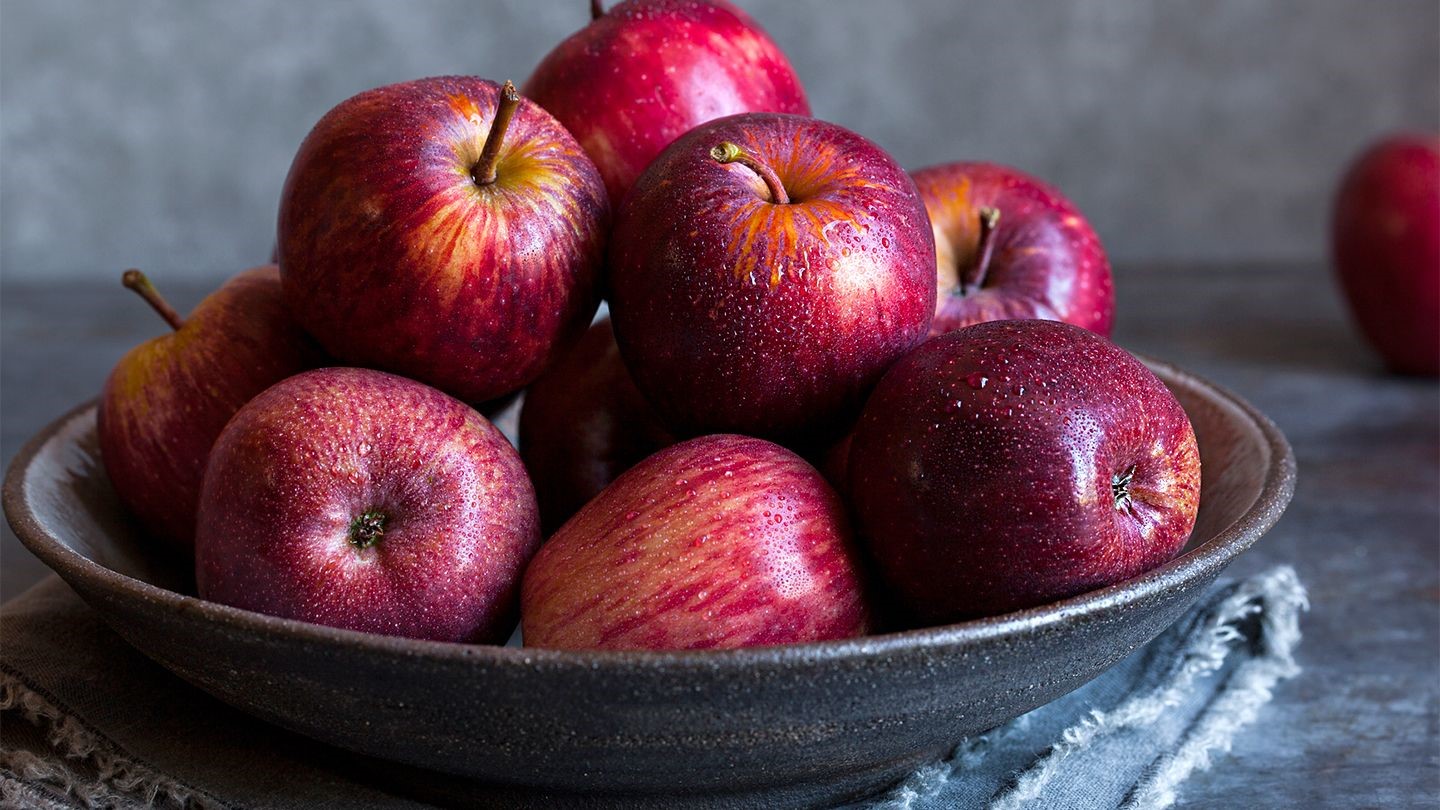
There is an old saying that “an apple a day keeps the doctor away”. How true is this saying? Well, a study by Boyer & Liu, 2004, found that, in the laboratory, apples contain very strong antioxidant activity, inhibit cancer cell proliferation, decrease lipid oxidation, and lower cholesterol.”
Apple Nutritional Contents
Apples are derived from the fruit of the tree known as Malus domestica. Though, in recent times, apples grown worldwide, the original home is the Asia territories. We have Hundreds of varieties of apples in recent times.
Researchers explained that, the phytochemical composition of apple nutrition differs greatly based on the type of apples. Besides, there are also changes in the phytochemicals during the maturation and ripening periods. Old red apples appear to be the highest in antioxidants according to some sources.
Common varieties of apples include:
- Red delicious
- Honeycrisp
- Fuji
- Gala
- Granny smith
- McIntosh
- Cortland
- Golden delicious
- Empire
- Braeburn
- Envy
- Jazz
- Cameo
- Jonagold
- Rome
- Macoun
- Zestar
- Mutsu
- Ambrosia
Apple Nutritional Contents
According to fdc.nal.usda.gov, one medium apple (about 182 grams) has the following:
- 94.6 calories
- 25.1 grams carbohydrates
- 0.5 gram protein
- 0.3 gram fat
- 4.4 grams fiber
- 8.4 milligrams vitamin C (14 percent daily value (DV)
- 195 milligrams potassium (6 percent DV)
- 4 micrograms vitamin K (5 percent DV)
- 0.1 milligram vitamin B6 (4 percent DV)
- 0.11 milligram manganese (3 percent DV)
Apple nutrition also includes vitamin A, vitamin E, niacin, folate, pantothenic acid, choline, betaine, calcium, iron, magnesium and phosphorus.

Scientific Studies on Apple health benefits
- Antioxidants
One study by Boyer and Liu, (2004), found that, in the United States, 22 percent of the phenolic antioxidants consumed from fruits are from apples, making them the largest single source of these compounds.
In one article by Link, (2018), Apples are ranked second to cranberries among all types of fruit for their total concentration of phenolic compounds. Phenolic compounds are a class of bioactive substances that includes flavonoids. Compared to all other types of fruit, apple nutrition has the highest portion of free phenolic compounds. That means these molecules are not bound to other compounds in the fruit that can slow down their beneficial activity in the body.
Research shows that beneficial antioxidants found in apple nutrition include:
- quercetin
- catechin
- phloridzin
- chlorogenic acid
Because of these special compounds, apples do more than combat free radicals. They also have anti-proliferative and beneficial cell-signaling effects. In studies, anti-inflammatory foods like apples are linked with the prevention of prostate cancer because of their supply of quercetin.
A previous study by Fabiani et al., (2016), demonstrates that certain protective phytochemicals in the skin of apples can help inhibit the reproduction of cancer cells within the colon. Since both cardiovascular disease and cancer are thought to be highly related to a condition called oxidative stress — which happens over time as damage to cells and DNA forms — the ability to fight off free radical damage and oxidation is what gives apples their healing power. This study was further cemented by Perez-Cornago et al., (2017) and agrees that apples are indeed part of a healing diet.
Ayala-Zavala et al., (2010), examines the antioxidant content of pears and apples, they found that diets that included the fruit peels had a significantly higher level of healthy fatty acids (higher plasma lipid levels) and antioxidant activity than diets that discarded the peels and only ate the fruit’s pulp.

- Avert Inflammation
Hyson, (2011), explained that high-antioxidant foods are associated with “improved outcomes related to cognitive decline of normal aging, diabetes, weight management, bone health, pulmonary function, and gastrointestinal protection.”
- Support Cardiovascular disease
Pectin as fiber is found in apples. Pectin lowers cholesterol levels naturally. A study by Aprikian et al., (2003), demonstrates that, when rats were fed a diet high in apple pectin extract and freeze-dried apples, they experienced significantly lower levels of cholesterol absorption and triglycerides than the control group.
Another study by Chang et al., (2013), conducted in a fifteen year period found that, overall, greater intake of fruits and vegetables was associated with lower risk of all-cause death and cardiovascular disease. There’s also evidence that antioxidant-rich fruits can play a role in preventing strokes, chronic obstructive pulmonary disease, diverticulosis and hypertension.
- High in Fiber
According to Ruggeri, (2018), with over four grams of fiber in everyone, “apples are an ultimate high-fiber food. Eating an apple is a great way to make sure you cover your bases of 25–30 grams daily. Apples are especially known for providing pectin”. She further noted that, “Pectin is a type of soluble fiber that works by binding to fatty substances in the digestive tract — including cholesterol and toxins — and promoting their elimination”.
The fiber found in apple nutrition helps make you feel full. It expands in your intestines and takes up volume. It’s also important for detoxification. Apple nutrition benefits the digestive system because pectin regulates the body’s use of sugars and cholesterol. It also helps cleanse the blood and digestive tract.
- Improve Digestive Health
Due to the high-fiber diet found to fight digestive issues like IBS (irritable bowel syndrome) and even cancers of the digestive system. Higher fruit intake is correlated with better general digestive health, especially of the colon, stomach and bladder. The phytonutrients found in apples can help protect the digestive organs from oxidative stress, alkalize the body and balance pH levels.
According to Axe, (2019), when it comes to natural constipation relief, consuming plenty of high-fiber foods is a great way to prevent or treat this issue. He notes. “Pectin in apple nutrition is also considered a natural diuretic. It has a mild laxative effect, so this can help combat bloating and uncomfortable water retention. Try either eating raw apples (remember to also eat the skin) or adding them to recipes by blending them first. You can also obtain benefits by juicing apples, although you want to avoid the types of high-sugar juices found in most grocery stores”.
- Good Source of Vitamin C
One article by Link, (2019), explained that, One medium apple supplies about 14 percent of your daily vitamin C. The author notes, “Vitamin C is considered a powerful antioxidant that’s important for skin, eye, immune and brain health. Like other antioxidants we obtain through fresh vegetables and fruits, vitamin C fights free radical damage and helps protect DNA and cells from mutation and malformation”.
The author further asserts that, research shows that vitamin C is crucial for maintaining a healthy metabolism and repairing tissue, especially in the eyes and skin. Vitamin C-rich foods like apples have natural anti-aging effects because they promote skin cell renewal, help heal wounds or cuts, guard against infections and harmful bacteria, and also block damage from UV light exposure.
- Supports Weight Loss
Ledoux et al., (2011), study found that higher fruit and vegetable intake is linked with protection against obesity. While apples provide high levels of important nutrients and antioxidants, they’re also low in calories since a high percentage of their volume is water and fiber.
- Fight Diabetes
Ford and Mokdad, (2001), study by found that eating five or more combined servings of fruits and vegetables daily significantly cut the risk of diabetes formation in adults. It might seem counterintuitive that fruits and vegetables, which naturally contain some sugar, are inversely associated with diabetes incidence, but this is shown time and time again in studies.
Certain flavonoids present in apples and other fruits are known to improve insulin sensitivity. This is key to preventing both diabetes and long-term weight gain. The other antioxidants and fiber found in apples also play a role in their anti-diabetic effects.
Additionally, apples are high in fiber, they’re considered a fruit that’s low on the glycemic index. Compared to refined carbohydrates or sweetened products, apples have the ability to unleash sugar into the bloodstream at a slower rate. This means they keep blood sugar levels more stable and prevent fluctuations in blood glucose that can potentially lead to insulin resistance.
- Fight Asthma Symptoms
A study by Boyer and Liu, 2004, demonstrates that, apples act like natural remedies for asthma. The study is link with general pulmonary health. The authors noted that, apple and pear intake was associated with a decreased risk of asthma and a decrease in bronchial hypersensitivity.
The study included about 600 individuals with asthma and 900 individuals without asthma and monitored their diets and lifestyles. Total fruit and vegetable intake was found to be only weakly associated with asthma, but apple intake demonstrated a stronger inverse relationship with asthma. The beneficial effect was seen in subjects who consumed at least two apples per week.
Juxtaposed to Onion, tea and red wine consumption, apples were seen as the most beneficial in the fight against asthma. This suggests that there are special interactions of apple flavonoids that help control asthma symptoms better than other antioxidants and nutrients.

- Good Source of Boron
Interestingly, Apples are one of the best natural sources of boron. Boron is a mineral that is important for building strong bones and helping to prevent osteoporosis. Boron uses and benefits include helping develop sex hormones, building muscle mass and supporting brain function. Some evidence also shows that low boron intake might be associated with fatigue, arthritis and mood changes.
Apples vs. Oranges vs. Bananas vs. Pears
According to Levy, 2018:
- Juxtaposed to apple nutrition, orange nutrition is higher in certain nutrients, including vitamin C, potassium, calcium and folate. Oranges are an excellent source of vitamin C. They contain over 100 percent of your daily requirement in one orange compared to only 10 percent to 14 percent in one apple. Apples are a bit higher in calories and provide more fiber than oranges. However, some people can tolerate oranges and not apples.
- Bananas are a high-sugar and high-starch fruit, but they actually have less sugar than apples (14 grams in a banana compared to 19 in an apple). Bananas are a lot higher in starch, but they also provide higher levels of some nutrients too. These include potassium, magnesium, vitamin C, folate and vitamin B6. One banana has about seven times as much folate and three times as much potassium as one apple. However, apples have slightly more vitamin E and K. Plus they are richer in flavonoids.
- Both apples and pears are fruits in the Rosaceae plant family. They are believed to originate in Asia. Both are rich in dietary fiber, providing more than fruits like oranges and bananas. Apples are known for providing pectin, but pears are actually a better source of this special type of fiber. As a soluble fiber, pectin works by binding to fatty substances in the digestive tract, including cholesterol and toxins, and promotes their elimination. There are a similar number of calories in a pear and an apple. Both provide about 100 calories and have between 17–19 grams of sugar. They also contain similar quantities of carbohydrates.
Apples, oranges, bananas and pears can provide a quick boost of energy before a workout because they’re natural sources of fructose and glucose sugar molecules. Fruit provides carbohydrates and can help enhance physical performance, concentration and stamina if you have a piece as a snack prior to hitting the gym.
The body uses sugar best around the time of exercise because we need glucose to replenish depleted glycogen reserves and help promote muscle recovery.

Conclusion
- Apple nutrition is high in fiber. Apple nutrition also provides pectin, vitamin C and antioxidants.
- Benefits of apple nutrition include improving digestion; helping with weight loss; preventing inflammation, heart disease, diabetes, asthma and constipation; and providing nutrients like boron, vitamin and flavonoid antioxidants.
The writer is on a mission to provide you and your family with the highest quality nutrition tips, scientific herbs and healthy recipes in the world.
DISCLAIMER This post is for enlightenment purposes only and should not be used as a replacement for professional diagnosis and treatments. Remember to always consult your healthcare provider before making any health-related decisions or for counselling, guidance and treatment about a specific medical condition.
The writer is an honorary Professor of Naturopathy Holistic Medicine, a chartered Management Consultant (ChMC), Chartered Institute of Management Consultant, Canada, President, Nyarkotey College of Holistic Medicine and currently, LLB level 300 law student. Contact: 0241083423/0541234556
References
- Boyer, J., & Liu, R. H. (2004). Apple phytochemicals and their health benefits. Nutrition journal, 3, 5. https://doi.org/10.1186/1475-2891-3-5
- Jeanelle Boyer and , Liu, 2004. Antioxidants of Apples. Semantic Scholar
- Aprikian O, Duclos V, Guyot S, Besson C, Manach C, Bernalier A, Morand C, Rémésy C, Demigné C.(2003) Apple pectin and a polyphenol-rich apple concentrate are more effective together than separately on cecal fermentations and plasma lipids in rats. J Nutr. Jun;133(6):1860-5. doi: 10.1093/jn/133.6.1860. PMID: 12771330.
- Ayala-Zavala, J. F., Rosas-Domínguez, C., Vega-Vega, V., & González-Aguilar, G. A. (2010). Antioxidant enrichment and antimicrobial protection of fresh-cut fruits using their own byproducts: looking for integral exploitation. Journal of food science, 75(8), R175–R181. https://doi.org/10.1111/j.1750-3841.2010.01792.x
- Hyson DA(2011). A comprehensive review of apples and apple components and their relationship to human health. Adv Nutr. Sep;2(5):408-20. doi: 10.3945/an.111.000513. Epub 2011 Sep 6. PMID: 22332082; PMCID: PMC3183591.
- Chang, A., Van Horn, L., Jacobs, D. R., Jr, Liu, K., Muntner, P., Newsome, B., Shoham, D. A., Durazo-Arvizu, R., Bibbins-Domingo, K., Reis, J., & Kramer, H. (2013). Lifestyle-related factors, obesity, and incident microalbuminuria: the CARDIA (Coronary Artery Risk Development in Young Adults) study. American journal of kidney diseases : the official journal of the National Kidney Foundation, 62(2), 267–275. https://doi.org/10.1053/j.ajkd.2013.02.363
- Christine Ruggeri, (2018). How Your Digestive System Works. https://draxe.com/health/how-your-digestive-system-works/
- Josh Axe, (2019). Natural Constipation Relief Remedies: Foods, Supplements + Practices.https://draxe.com/health/natural-constipation-relief-remedies/
- Rachael Link, (2019). Vitamin C Benefits the Immune System — and So Much More. https://draxe.com/nutrition/vitamin-c-benefits/
- Ledoux TA, Hingle MD, Baranowski T(2011). Relationship of fruit and vegetable intake with adiposity: a systematic review. Obes Rev. 2011 May;12(5):e143-50. doi: 10.1111/j.1467-789X.2010.00786.x. PMID: 20633234
- Ford ES, Mokdad AH(2011). Fruit and vegetable consumption and diabetes mellitus incidence among U.S. adults. Prev Med Jan;32(1):33-9. doi: 10.1006/pmed.2000.0772. PMID: 11162324.
- Jillian Levy, (2019) Apple Nutrition — The Ultimate Gut & Heart-Friendly Fruit. https://draxe.com/nutrition/apple-nutrition/
- Rchael Link, 2018. Cranberries: Top 6 Benefits of These Antioxidant Superfruits. https://draxe.com/nutrition/cranberries/
- Perez-Cornago, A., Travis, R. C., Appleby, P. N., Tsilidis, K. K., Tjønneland, A., Olsen, A., Overvad, K., Katzke, V., Kühn, T., Trichopoulou, A., Peppa, E., Kritikou, M., Sieri, S., Palli, D., Sacerdote, C., Tumino, R., Bueno-de-Mesquita, H., Agudo, A., Larrañaga, N., Molina-Portillo, E., … Key, T. J. (2017). Fruit and vegetable intake and prostate cancer risk in the European Prospective Investigation into Cancer and Nutrition (EPIC). International journal of cancer, 141(2), 287–297. https://doi.org/10.1002/ijc.30741
- Fabiani R, Minelli L, Rosignoli P (2016). Apple intake and cancer risk: a systematic review and meta-analysis of observational studies. Public Health Nutr. 2016 Oct;19(14):2603-17. doi: 10.1017/S136898001600032X. Epub Mar 22. PMID: 27000627.









